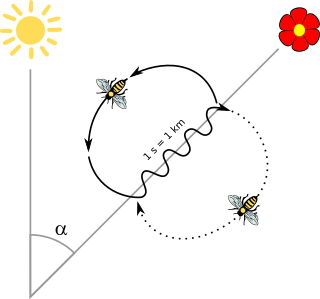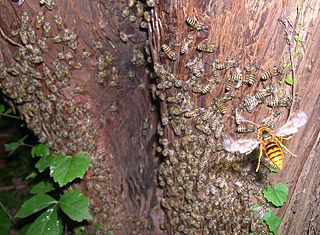
A honey bee is a eusocial flying insect within the genus Apis of the bee clade, all native to mainland Afro-Eurasia. After bees spread naturally throughout Africa and Eurasia, humans became responsible for the current cosmopolitan distribution of honey bees, introducing multiple subspecies into South America, North America, and Australia.

Varroa destructor, the Varroa mite is an external parasitic mite that attacks and feeds on the honey bees Apis mellifera and Apis cerana. The disease caused by the mite in this genus is called varroosis.

Waggle dance is a term used in beekeeping and ethology for a particular figure-eight dance of the honey bee. By performing this dance, successful foragers can share information about the direction and distance to patches of flowers yielding nectar and pollen, to water sources, or to new nest-site locations with other members of the colony.

Varroa jacobsoni is a species of mite that parasitises Apis cerana. The more damaging Varroa destructor was previously included under the name V. jacobsoni, but the two species can be separated on the basis of the DNA sequence of the cytochrome oxidase I gene in the mitochondrial DNA.

The dwarf honey bee, Apis florea, is one of two species of small, wild honey bees of southern and southeastern Asia. It has a much wider distribution than its sister species, Apis andreniformis. First identified in the late 18th century, Apis florea is unique for its morphology, foraging behavior and defensive mechanisms like making a piping noise. Apis florea have open nests and small colonies, which makes them more susceptible to predation than cavity nesters with large numbers of defensive workers. These honey bees are important pollinators and therefore commodified in countries like Cambodia.

Apis laboriosa or Himalayan giant honey bee, is the world's largest honey bee; single adults can measure up to 3.0 cm (1.2 in) in length. Before 1980, Apis laboriosa was considered to be a subspecies of the widespread Apis dorsata, the giant honey bee, but in 1980 and for almost 20 years thereafter it was elevated to the rank of a separate species. It was classified once again as a subspecies of Apis dorsata by Michael S. Engel in 1999, but was confirmed as a full species in 2020 on the basis of co-occurrence with Apis dorsata at many sites with no sign of interbreeding. It is highly adapted to its highland habitat in behavior.

Apis koschevnikovi, Koschevnikov's honey bee, is a species of honey bee which inhabits Malaysian and Indonesian Borneo, where it lives sympatrically with other honey bee species such as Apis cerana.

Apis nigrocincta is a species of honey bee that inhabits the Philippine island of Mindanao as well as the Indonesian islands of Sangihe and Sulawesi. The species is known to have queens with the highest mating frequencies of any species of the tribe Apini.

Apis dorsata, the rock bee or giant honey bee, is a honey bee of South and Southeast Asia. They are typically around 17–20 mm (0.7–0.8 in) long and nests are mainly built in exposed places far off the ground, like on tree limbs, under cliff overhangs, and under buildings. These social bees are known for their aggressive defense strategies and vicious behavior when disturbed. Though not domesticated, indigenous peoples have traditionally used this species as a source of honey and beeswax, a practice known as honey hunting.

Flower mantises are praying mantis species that use a special form of camouflage referred to as aggressive mimicry, which they not only use to attract prey, but avoid predators as well. These insects have specific colorations and behaviors that mimic flowers in their surrounding habitats. This strategy has been observed in other mantises including the stick mantis and dead-leaf mantis. The observed behavior of these mantises includes positioning themselves on a plant and either inserting themselves within the irradiance or on the foliage of the plants until a prey insect comes within range. Many species of flower mantises are popular as pets. The flower mantises are non-nocturnal group with a single ancestry, but the majority of the known species belong to family Hymenopodidea.

Cymbidium mosaic virus (CymMV) is a plant pathogenic virus of the family Alphaflexiviridae.

Apis cerana indica, the Indian honey bee, is a subspecies of Asiatic honey bee. It is one of the predominant bees found and domesticated in India, Pakistan, Nepal, Myanmar, Bangladesh, Sri Lanka, Thailand and mainland Asia. Relatively non-aggressive and rarely exhibiting swarming behavior, it is ideal for beekeeping.

Apis cerana japonica is a subspecies of the eastern honey bee native to Japan. It is commonly known as the Japanese honey bee. This subspecies was determined, through an analysis of mitochondrial DNA, to have originally come from the Korean peninsula. They have been observed moving into urban areas in the absence of natural predators.

The Asian hornet, also known as the yellow-legged hornet or Asian predatory wasp, is a species of hornet indigenous to Southeast Asia. It is of concern as an invasive species in some other countries.

Apis cerana, the eastern honey bee, Asiatic honey bee or Asian honey bee, is a species of honey bee native to South, Southeast and East Asia. This species is the sister species of Apis koschevnikovi and both are in the same subgenus as the western (European) honey bee, Apis mellifera. A. cerana is known to live sympatrically along with Apis koschevnikovi within the same geographic location. Apis cerana colonies are known for building nests consisting of multiple combs in cavities containing a small entrance, presumably for defense against invasion by individuals of another nest. The diet of this honey bee species consists mostly of pollen and nectar, or honey. Moreover, Apis cerana is known for its highly social behavior, reflective of its classification as a type of honey bee.
A. c. japonica may refer to:

3-Hydroxyoctanoic acid is a beta-hydroxy acid that is naturally produced in humans, other animals, and plants.
Friedrich Ruttner was an Austrian SA-member, NSDAP member, SS-physician, neurologist, zoologist and bee expert. He became internationally known for his advances in honey bee breeding, instrumental insemination, classification of various subspecies and as a co-founder of Apidologie.
The evolution of the Sacbrood virus (SBV) is characterized by the genomic changes that have occurred in SBV since its initial discovery in 1913, which have enabled the virus to continuously infect a wide array of honeybee colonies. SBV is single stranded RNA virus (genus: Iflavirus) that most commonly infects honeybee larvae, and is known to wipe out entire honeybee colonies quickly. Due to SBV, there has been sharp declines in honey bee populations in Europe, as well as a 30% decline each year in U.S. colonies. Studies on the evolution of SBV have arose in hopes to stop these colony devastations. SBV is one of the most widely studied honeybee viruses in terms of genomic analysis, leading to it having the highest number of complete genomes isolated compared to any other viruses known to honeybees. Through these genome studies, it has been found that there are two distinct lineages of SBV, each characterized by a high mutation rate, leading to multiple subtypes in both lineages. In studying how these lineages have evolved through time, new discoveries in their pathogenicity and different honeybee resistance mechanisms have been unveiled.
Apis karinjodian, the Indian black honey bee, is a species of genus Apis which was reported recently from India. The currently known distribution of A. karinjodian covers nearly the entire Central to Southern Western Ghats, where it is endemic, and includes the ghat regions in the states of Kerala, Tamilnadu, Karnataka and Goa. The original paper discovering and describing this species also proposes that A. indica and A. cerana are distinct species, thus raising the total number of known cavity-nesting Honeybees in the Indian subcontinent to three, whereas before, A. indica was considered a subspecies of A. cerana.
















